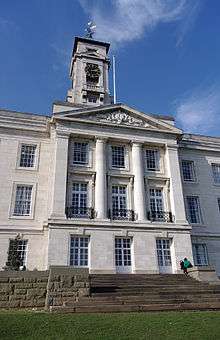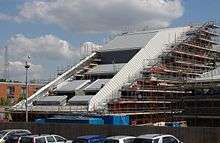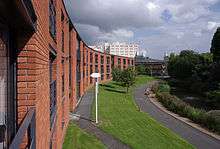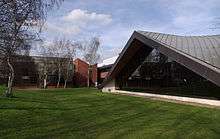Campuses of the University of Nottingham
The University of Nottingham operates from four campuses in Nottinghamshire and from two overseas campuses, one in Ningbo, China and the other in Semenyih, Malaysia. The Ningbo campus was officially opened on 23 February 2005 by the then British Deputy Prime Minister, John Prescott, in the presence of Chinese education minister Zhou Ji and State Counsellor Chen Zhili. The Malaysia campus was the first purpose-built UK university campus in a foreign country and was officially opened by Najib Tun Razak on 26 September 2005. Najib Tun Razak, as well as being a Nottingham alumnus, was Deputy Prime Minister of Malaysia at the time and has since become Prime Minister of Malaysia.
University Park Campus and Jubilee Campus are situated a few miles from the centre of Nottingham, with the small King's Meadow Campus nearby. Sutton Bonington Campus is situated 12 miles (19 km) south of the central campuses, near the village of Sutton Bonington.[1]
University Park Campus

University Park Campus (52°56′24″N 1°11′40″W / 52.9399°N 1.1945°W) is the main campus of the university. A few miles from the centre of Nottingham, the 330 acres (1.3 km²) site is one of the largest university campuses in the United Kingdom, and home to the majority of the university's 43,561 students.[2] The campus contains 12 halls of residence, of which the largest is Hugh Stewart Hall, as well as academic and administrative buildings. The campus contains 13 listed buildings.
Gardens
The campus is widely regarded for the extent of its greenery, and regularly wins awards for its landscaping.[3] Of particular note are the formal Jekyll Garden, allegedly designed by Gertrude Jekyll, next to Lenton and Wortley Hall; the walled Highfield Garden near the Trent Building, which is home to the national collection of Canna; and the new Millennium Garden, formally opened in 2000, which has won several awards. In addition there is extensive planting elsewhere on campus, particularly in lakeside Highfields Park.
University Park Campus halls of residence
- Ancaster Hall
- Cavendish Hall
- Cripps Hall
- Derby Hall
- Florence Boot Hall
- Hugh Stewart Hall
- Lenton and Wortley Hall
- Lincoln Hall
- Nightingale Hall
- Rutland Hall
- Sherwood Hall
- Willoughby Hall
Notable buildings
Trent Building

The Trent Building serves as one of the main administrative buildings of the University of Nottingham. It also contains academic facilities, principally for the arts and social sciences.
London architect Morley Horder created the Trent Building in the classical architectural style. The building is topped by a campanile (clock tower), is built of Portland stone and is protected as a grade II listed building. King George V and Queen Mary presided at the building's opening in 1928, and the building's Great Hall has hosted many distinguished visitors, including Albert Einstein, Mahatma Gandhi and Queen Elizabeth II.
The writer D. H. Lawrence described the building as looking like an "iced cake".[4]
The main buildings of the university’s campuses in China and Malaysia are both modelled on University Park’s iconic Trent Building. In the case of the China campus this includes an exact replica of the clock tower.
Hallward Library
The Hallward Library, the principal library of the University of Nottingham, was opened in 1972. It was designed by the architect H. Faulkner-Brown and won a RIBA prize. It is named after Dr Bertrand Hallward, first vice-chancellor of the university.
It houses the university's arts, humanities, law and social sciences collections and a European Documentation Centre.
Portland Building
The Portland Building is faced with Portland stone but is actually named after William Arthur Henry Cavendish-Bentinck, 7th Duke of Portland, who was the university's second chancellor. It houses the University of Nottingham Students' Union, URN – Student Radio for Nottingham and NSTV - Student Television for Nottingham.
Other notable buildings
Jubilee Campus



Jubilee Campus (52°57′10″N 1°11′14″W / 52.9529°N 1.1872°W) primarily houses the Computer science and Nottingham University Business School. The campus is also the location of the National College for School Leadership and the University's International Office.
The campus opened in 1999, and is located about a mile to the east of the main University Park Campus on the site of the former Raleigh Bicycle Company factory. The campus plan and the buildings for first phase of the campus were designed by the architects Michael Hopkins and Partners following selection through an architectural design competition managed by RIBA Competitions and won the 2000 BCI Award for "Building of the Year" and the 2001 RIBA Journal Sustainability Award. The campus name derives from the fact that 1998 was the Golden Jubilee of the granting of the Royal Charter that made the University an independent degree-granting organisation.
Like the University Park Campus Jubilee has been constructed around an artificial lake and with similar green surroundings. The Hopkins buildings also contains many innovative environmental elements such as living roofs (Sedum) aiding storm drainage, insulation and promoting biodiversity, and solar panels. Particularly striking is the library, the Sir Harry and Lady Djanogly Learning Resource Centre, a circular building situated in the middle of the lake with only one, spiraling, floor.
For the second phase of the campus, MAKE architects were retained by the university. They produced a revised campus plan, which moved away from Hopkins north-south orientation, and creates an east-west axis beyond the confines of the site.[5] The first stage includes a group of three prominent buildings by the practice.
The new plan is centred on Aspire, the country's tallest piece of free-standing art,[6] which was also designed by MAKE. The Aspire sculpture is described by the university thus:
Aspire stands for the aspirations of the city and people of Nottingham. Aspire stands for the ambition, knowledge and world leading innovation of The University of Nottingham. Above all, Aspire stands as a towering affirmation of optimism for the future.[7]
International House and the Amenity Building have facades in multiple shades of red terracotta, whereas the Gateway Building is covered in galvanized zinc shingles. Critical reception to MAKE's buildings for the second phase has been mixed. The new campus buildings were runner up for Building Design magazine's 2009 Carbuncle Cup.[8]
Jubilee Campus halls of residence
- Newark Hall – undergraduate, 400 students
- Southwell Hall – undergraduate, 200 students
- Melton Hall – postgraduate, 140 students
Each of the above halls are ensuite, and Southwell and Newark are catered. Many students studying on the main campus live in halls on Jubilee. Transport between campuses is provided by a university-funded hopper bus which is free to use.
King's Meadow Campus

King's Meadow Campus (52°56′19″N 1°10′19″W / 52.9386°N 1.1719°W) is a 16 acres (64,750 m²) campus that was formerly the East Midlands studios of Carlton Central. The University's department of Manuscripts and Special Collections is now housed at the King's Meadow Campus. Information Services and much of the Finance Department are now also housed at this site.
Sutton Bonington Campus

The Sutton Bonington Campus (52°49′49″N 1°15′09″W / 52.8302°N 1.2524°W) is a site of the University of Nottingham, and houses the School of Biosciences and the School of Veterinary Medicine and Science. The campus is a 420 hectare (4.2 km²) site situated in a rural location near Sutton Bonington village, 12 miles (19 km) south of the main, University Park Campus, and 1 mile (2 km) from Junction 24 of the M1 motorway. The campus has its own crest and motto: Aras . Seris . Metis. The campus contains research buildings and teaching facilities, a large library and is also home to Bonington Halls, the University's largest hall of residence, which accommodates around 650 students (in reality it is a series of small halls rather than one big hall - the name has recently changed to reflect this). A 400 hectare (4 km²) commercial farm, University Farm, and a dairy are also part of the site.
The campus has a refectory, a small private function room (Oak Room) for 10-20 people; a student bar and linked JCR, and a room linked to the bar (The Octagon - often used for external meetings), and a shop, C-Store. The campus also has a single cashpoint.
Sports facilities include a gym, a sports hall, and an astro-turf pitch. External sports facilities run alongside the University between the main road and the railway line. There is also a renovated squash court which is now a music room available to students in 'Music Soc' and a bouldering wall available to students in 'SB Climbing'.
Travel into Nottingham is facilitated by a free shuttle bus between the distant and more central campuses, which leaves approximately twice an hour and takes 25 minutes. There was no railway station nearby until January 2009 when East Midlands Parkway station was opened approximately 2.5 miles (4.0 km) away. Kegworth railway station was closed in 1968, which meant that, prior to the opening of East Midlands Parkway, the closest stations were at Loughborough or Nottingham (20-30 mins by taxi). The East Midlands Airport is very close with some flight paths being over the campus itself. Trent Barton run the Skylink bus service which connects Sutton Bonington to the airport approximately every hour on its Nottingham to Loughborough route.
The campus was formerly the Midlands Agricultural and Dairy College before merging with the University of Nottingham in 1947. The College was originally located in Kingston on Soar, about a two-minute walk down the road from the current campus, but relocated to its current location after the First World War. The site (which had been built but not yet occupied prior to the war) was used as a prisoner-of-war camp during the First World War.[9] It was from there that a group of 21 German officers, led by Captain Karl von Müller, escaped through an underground tunnel dug from one of the huts. 15 tonnes of soil are said to have been removed and hidden under the tiers of a lecture room. All but one of the prisoners were recaptured.
The University of Nottingham opened the doors of its School of Veterinary Medicine and Science in September 2006, the first vet school to open in the UK in over fifty years. In its first year, there were 96 students attending the faculty on its five-year course, but the number has grown, with 110 students having been admitted more recently. There is now also a six-year program which includes a preliminary year to teach basic biology and chemistry relevant to the degree. This has been set up with the aim of encouraging more people to do the subject by making it available to those with a degree that is not relevant, or without biology and chemistry A-level.
Student organisations
The Sutton Bonington Campus is the home of the Sutton Bonington Students' Union Guild, an association of the University of Nottingham Students' Union. All officers of the 'SB Guild' are non-sabbatical and elected annually by an anonymous ballot, which follows the Students' Union procedure of using STV. The Guild used to be separate from the union, and still has a degree of independence. The Guild run 40 of its own clubs and societies. In addition it also has its own international students organisation (ISSB). Societies at Sutton Bonington Campus are student-run and apply directly to the Guild for funding- they are also separate from the main university societies in many cases.
The old students association for both the campus, and the hall of residence is known as OKA (the Old Kingstonian Association, the name pre-dating the move to Sutton Bonington), and its members include both students from the Midlands Agricultural and Dairy College, and from the University. OKA produces a publication known as Agrimag annually (and has done so since at least the 1920s, when it was called the M.A.D.C Magazine). OKA organises a reunion weekend on the third weekend in November every year for recently graduated students to return.
Bonington Student Village
Bonington Student Village is the name given by the current provider to the University's halls of residence at Sutton Bonington. It is a mixed sex group of houses and halls, holding both undergraduates and postgraduates, of varying age and design holding between eight and sixty people. Bonington Student Village houses approximately 650 students and is managed by Campus Living Villages (CLV). The houses and halls at Sutton Bonington are named after local villages and are as follows:
- Kingston
- Normanton
- Wymeswold
- Ratcliffe
- Rempstone
- Kegworth
- Dishley
- Hathern
- Lockington
- Zouch
- Stanford
- Barton
- Costock
- Thrumpton
School of Veterinary Medicine and Science
Nottingham Vet School was the first brand new, purpose-built veterinary school in the UK for over 50 years. The academic staff of the School work within 5 strategic research areas: Infection and Immunity; Population Health and Welfare; Comparative Medicine; Reproductive Biology and Veterinary Educational Research. Research is closely aligned with that in the School of Biosciences with whom some research facilities and equipment are shared. The involvement of Clinical Associates and other organisations within the research programs enables the identification of clinical problems in the field and the rapid application of investigational science to these problems in both production and companion animal species.
School of Biosciences
The School of Biosciences has 65 academic staff, 700 undergraduate students and 270 post-graduate students, The school houses five divisions:
- Division of Plant Sciences, incorporating NASC (Nottingham Arabidopsis Stock Centre) and CPIB (Centre for Plant Integrative Biology)
- Division of Nutritional Science
- Division of Food Science, incorporating NCMH (National Centre for Macromolecular Hydrodynamics)
- Division of Animal Physiology, incorporating the Multi-disciplinary Centre for Integrative Biology and the Centre for Applied Bioethics
- Division of Agricultural and Environmental Sciences
The division of agricultural and environmental sciences is further split into four departments, and also contains the "rural business research unit" and supervises the university farm
- Animal Production
- Crop Science, incorporating TCRU (Tropical Crop Research Unit) and UNACRA (University of Nottingham/ADAS Centre for Research in Agronomy)
- Environmental Science
- Management and Economics
University Farm
The farm exists to provide high quality facilities, resources and opportunities for research with crops and animals. It also has a key educational role by providing an environment for effective tuition of students in Biosciences, and Veterinary science. The farm is run commercially to be self-financing whilst still fulfilling its role as a teaching and research resource. The farm manager is currently Jon Clatworthy. The farm is a 400 hectare mixed farm, with an emphasis on dairy and arable production.
The dairy herd consists of 180 cows, which are milked using a robot milking system (part of a recent 2 million-pound investment in the dairy). The farm also has 350 breeding ewes, and maintains beef, pig and poultry research units.
320 Hectares are devoted to arable crops including cereals and oilseed rape, 20 Hectares of which have been converted to organic production. The further 80 hectares of land is used for an intensively managed rotation of grass, fodder crops and maize for silage.
History
The first foundations of the current site at Sutton Bonington date back to the founding of the Midland Dairy Institute in the mid-19th century. The institute gave lectures and short coursers in such subjects as butter and cheese production, the institute had no fixed home but instead toured the various agricultural shows in the area. University College Nottingham was founded in 1877, and in 1892 co-operated with Nottingham County Council in establishing an Agricultural Department. Then in 1895 the Midland Dairy Institute in conjunction with the five County Councils of Nottingham, Derby, Leicester, Kesteven and Lindsey, agreed to join forces, in an effort to provide both theoretical and practical instruction in Agriculture, and especially Dairying. Lord Belper leased, to the united body his Fields Farm at Kingston, consisting of 176 acres (0.71 km2) of land, half being in permanent grass, and half arable, to act as a permanent base for the institute. In 1900 the agricultural department of Nottingham University College was combined with the Dairy institute at Kingston, and additional buildings were erected shortly afterwards. In 1905 the Institute changed its name to the Midland Agricultural and Dairy College.
In 1912 another farm of 85 acres (340,000 m2), situated in Sutton Bonington parish, but near to the Kegworth Station, was acquired. Initially intended for an experimental station. It however became apparent that the institute was rapidly running out of space, and construction of a brand new purpose built site at Sutton Bonington began. The construction of the new site had not been completed before the outbreak of the First World War, and the new buildings were appropriated by the government to house German prisoners of war. The college did not regain the site at Sutton Bonington until 1919 and did not fully transfer to the new site until 1928. During the 1930s the college started to offer degree level courses in association with University College Nottingham and London University. As the Second World War started the college was once again appropriated, this time to be used as a training centre for the Women's Land Army (WLA). After a year, however, it was decided that it was unnecessary to provide this level of training, and the college was returned to its original purpose.
In 1947–48 the college merged with Nottingham University College, to form the new Nottingham University (which was granted its charter in 1948), Sutton Bonington was initially home to two of the university’s six faculties (Agriculture and Horticulture). This move was part of a major shift in the teaching of agricultural sciences in the region. Each of the original local authorities set up their own agricultural college to teach practical agriculture:
- Brackenhurst College, Nottinghamshire (now part of Nottingham Trent University)
- Broomfield College, Derbyshire (now part of Derby College)
- Brooksby College, Leicestershire (now part of Brooksby-Melton College)
- Caythorpe College, Kesteven (closed 2001)
- Riseholme College, Lindsey (now part of Lincoln University),
In the meantime the new faculties at Sutton Bonington quickly phased out practical courses and instead focused on academic research and graduate and post-graduate teaching. It was initially intended that the new colleges would feed their brightest and most able students into the new University.
The site at Sutton Bonington continued to grow during the latter part of the 20th century, during this period the two initial faculties were merged into one: the faculty of Agricultural and Food Sciences. The end of the 20th century saw the faculty initially merged with the faculty of Biology to form the School of Biology. At the time this was seen as a move to transfer the biology department from University Park to Sutton Bonington, in a move designed to free up much needed building land, the university however denied that this was their motive. Shortly after the purchase of the new Jubilee Campus, the school was split into the School of life sciences (based at University Park) and the School of Biosciences (based at Sutton Bonington). This period also saw the construction of new Plant and Food science buildings at Sutton Bonington.
2006 saw the opening of the School of Veterinary Medicine and Science on the campus, in brand new purpose built buildings. This was the first new vet school in the UK for over 50 years, and was seen to be part of the government's response to the 2001 foot and mouth epidemic. Controversially, the building of the new school was partly funded by leasing out the halls of residence, catering facilities, bar and shop, to private companies (CRM andSodexo).
Climate
The warmest months are July and August, with average highs of just over 21 °C, whilst the coldest month is January, with a temperature range of 1.2 °C to 6.9 °C. Maximum and minimum temperatures throughout the year are around the England average. The highest temperature recorded at Sutton Bonington was 34.8 °C on 3 August 1990, a temperature that was unbeaten in the heatwave of 2003.[10] Frost occurs typically between November and April, with an average of 48 days a year with frost recorded. The sunniest months are July, August and May (in that order).
The average annual rainfall is about 606 millimetres (24 in), with October to January being the wettest period although June is the wettest month, compared with the national average of 838 millimetres (33 in).[11] The driest months are May, February and July (in that order).
Below are average temperature and rainfall figures taken between 1981 and 2010 for the official weather station at the Sutton Bonington campus itself.
| Climate data for Sutton Bonington, elevation 48m, 1981-2010 | |||||||||||||
|---|---|---|---|---|---|---|---|---|---|---|---|---|---|
| Month | Jan | Feb | Mar | Apr | May | Jun | Jul | Aug | Sep | Oct | Nov | Dec | Year |
| Average high °C (°F) | 7.2 (45) |
7.5 (45.5) |
10.3 (50.5) |
12.9 (55.2) |
16.3 (61.3) |
19.2 (66.6) |
21.7 (71.1) |
21.4 (70.5) |
18.4 (65.1) |
14.2 (57.6) |
10.0 (50) |
7.3 (45.1) |
13.9 (57) |
| Average low °C (°F) | 1.6 (34.9) |
1.3 (34.3) |
3.0 (37.4) |
4.1 (39.4) |
6.8 (44.2) |
9.8 (49.6) |
11.9 (53.4) |
11.9 (53.4) |
9.9 (49.8) |
7.2 (45) |
4.1 (39.4) |
1.7 (35.1) |
6.1 (43) |
| Average precipitation mm (inches) | 52.2 (2.055) |
38.9 (1.531) |
43.9 (1.728) |
48.9 (1.925) |
44.2 (1.74) |
60.2 (2.37) |
54.1 (2.13) |
55.5 (2.185) |
51.0 (2.008) |
61.0 (2.402) |
54.5 (2.146) |
55.9 (2.201) |
620.2 (24.417) |
| Average rainy days (≥ 1.0 mm) | 10.9 | 9.1 | 10.6 | 9.7 | 8.7 | 9.4 | 8.7 | 8.6 | 8.2 | 10.2 | 10.2 | 10.9 | 115.2 |
| Mean monthly sunshine hours | 52.3 | 74.4 | 107.4 | 143.9 | 178.2 | 158.1 | 188.0 | 179.0 | 134.1 | 104.0 | 60.9 | 43.3 | 1,423.5 |
| Source: Met Office[12][13] | |||||||||||||
Gallery
 The Food Sciences Division
The Food Sciences Division- Plant Sciences Division
 The Londis shop
The Londis shop- Barton, Stanford and Zouch houses, part of Bonington Halls
- Vet School
See also
References
- ↑ "Maps & Directions". University of Nottingham. Retrieved 2007-08-01.
- ↑ "PMI Home Student Statistics 2012/13". Nottingham.ac.uk. University of Nottingham. Retrieved 27 April 2013.
- ↑ Nottingham University Estate Office, Awards and Accolades
- ↑ University Park Gardens Guide and Tree Walk
- ↑ Building review by Peter Wilson in Architect' Journal 2 October 2008
- ↑ Press Release: Unveiled: design for Britain's tallest free-standing work of public art. 18 January 2008
- ↑ Aspire sculpture microsite on University of Nottingham website
- ↑ "Liverpool Ferry Terminal wins Carbuncle Cup 2009", Building Design magazine, 28 August 2009
- ↑ Cluett, Douglas (October 1982). Discovering Sutton Bonington Past and Present. Sutton Bonington Local History Society. ISBN 0-9508309-0-9.
- ↑ Met Office Hot spell August 1990
- ↑ "England 1971-2000 averages". Met Office. 2001. Archived from the original on 5 June 2011. Retrieved 2010-10-26.
- ↑ "Sutton Bonington 1981–2010 averages". Station, District and regional averages 1981-2010. Met Office. Retrieved 2012-11-04.
- ↑ "Sutton Bonnington 1971-2000 averages". Met Office.
External links
- Official website
- Photographs of The Jubilee Campus, including the Aspire Tower from Nottingham21
- Jubilee Campus Nottingham — a collection of photographs and slide show
